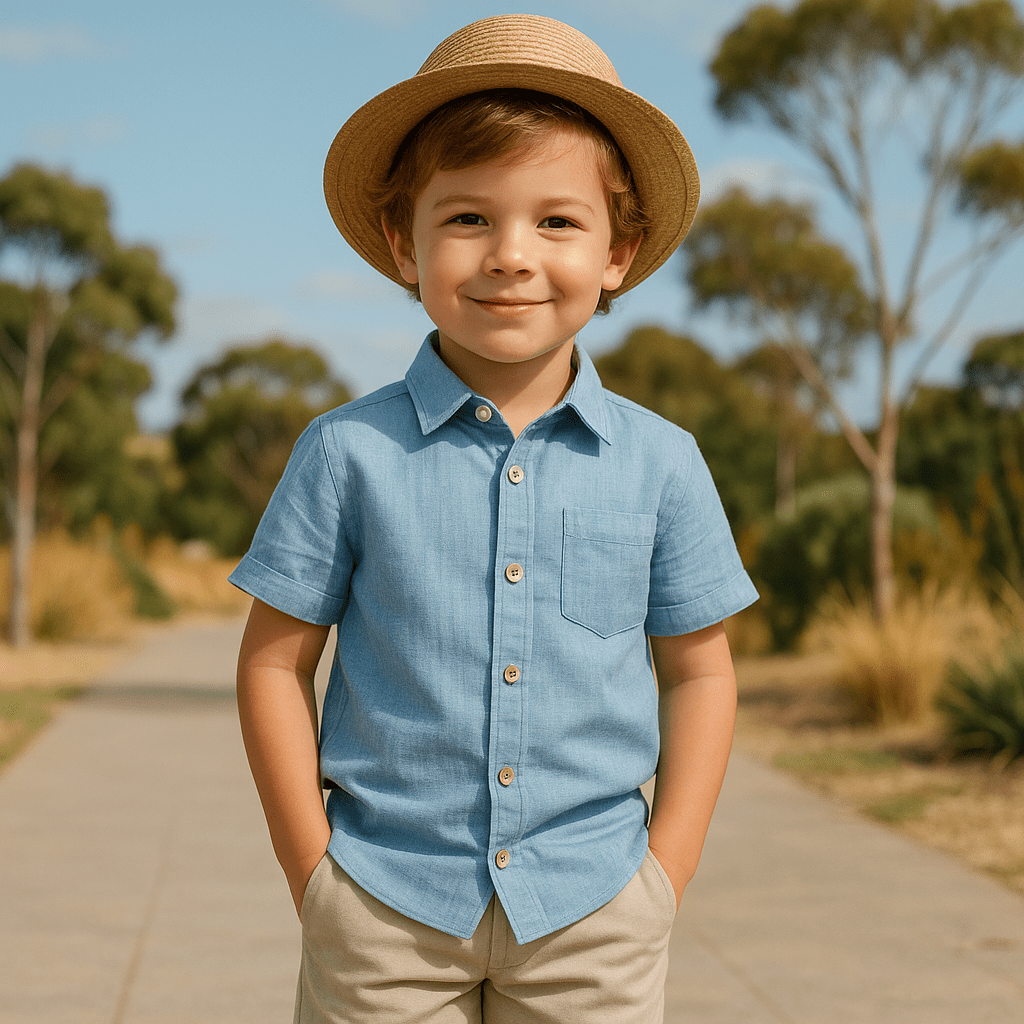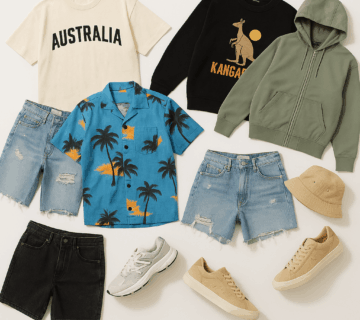Children’s clothes for Australia: Climate-smart choices
In Australia’s sun-filled summers and cooler winters, selecting the right children’s clothes means balancing comfort with practicality. The key lies in choosing breathable fabrics like cotton and bamboo that help regulate body temperature. For winter, layering with soft knits, fleece, and wool is the smart choice. And when it comes to active kids, always prioritise movement-friendly, stretchable pieces that can keep up with their energy. Fashion isn’t just about looks, it’s also about comfort that lasts through playtime, nap time, and everything in between.
Sustainable and eco-conscious fashion options
There’s a growing shift among Australian parents towards sustainable children’s clothes. Eco-conscious clothing is no longer a niche, it’s becoming the norm. Many parents now prefer to buy from brands that use organic materials and follow ethical production methods. Whether it’s GOTS-certified cotton or recycled materials, these choices not only reduce environmental impact but also ensure safety and comfort for sensitive young skin. Even better, sustainable kids’ clothes are often more durable, giving you better value in the long run.
Local favourites and established Aussie brands
Australian children’s fashion is buzzing with creativity and quality. Local brands lead the way with designs that are practical, stylish, and season-appropriate. Many Aussie labels focus on sun-safe wear, playful patterns, and gender-neutral designs. Whether you’re after laid-back beachwear or charming everyday basics, Australian-made kidswear offers a mix of aesthetics and function that’s hard to beat. Parents love the homegrown feel, and kids adore the quirky, colorful prints.
Buying second-hand, swapping, and renting smartly
Children grow, fast. One minute they’re fitting into a size 4, the next they’re jumping into size 6. That’s why many Australian families are turning to second-hand clothing, clothing swaps, and rental options. Not only does it reduce fashion waste, but it also saves money. Some communities host clothing swap events, turning a simple wardrobe refresh into a fun social outing. And for special occasions, renting a fancy outfit just makes sense. It’s practical, budget-friendly, and eco-wise.
Size guides, fit, and shopping tips
Size confusion is common when shopping for kids. Growth spurts can sneak up on you, so it’s usually wise to buy a size up, especially for toddlers and preschoolers. Choosing elastic waists, adjustable straps, and flexible fabrics also ensures clothes can accommodate growth without constant replacements. When buying online, always measure your child and check the brand’s size guide. And don’t forget the return policy, sometimes, even the best guess can be off by a mile.
Quality-related concerns for tweens and youth sizing
As children approach their pre-teens, sizing can become a real challenge. Many parents notice that clothing in sizes 8-16 often becomes shorter, tighter, or more fitted, sometimes at the expense of comfort and age-appropriateness. Choosing brands that respect the need for playful, modest styles in older kids is important. When needed, mixing youth and adult basics can offer a better fit without compromising on comfort or personal style.
Avoiding harmful chemicals in kids’ clothing
Little ones have delicate skin and that means steering clear of harsh chemicals in clothing is a must. Some cheap fabrics can contain irritants or harmful dyes. Opting for clothes made from untreated, natural fibers like organic cotton helps reduce the risk of rashes or allergic reactions. Look for certifications that indicate chemical-free processing, or better yet, go for second-hand items that have already been washed multiple times.
Where to shop: online versus retail
The beauty of shopping in Australia is the blend of modern convenience and local charm. Online retailers offer wide selections, fast shipping, and access to international brands. Meanwhile, in-store shopping allows you to feel the fabric, check the fit, and support local businesses. Farmers markets, boutique stores, and pop-up stalls often carry unique handmade items you won’t find elsewhere. It’s the best of both worlds, depending on your needs and time.
Budget-friendly strategies and value-per-wear mindset
It’s easy to overspend on children’s clothes, especially with all the cute options out there. But smart parents focus on value per wear. Instead of buying dozens of trendy items, build a core wardrobe of quality basics. Choose pieces that can mix and match, wash well, and grow with your child. Investing in sturdy staples like jackets, neutral tees, and durable shoes saves money in the long run. Style can still shine with a few bright or bold accessories.
Building a capsule wardrobe for Aussie kids
A capsule wardrobe is a game-changer. It’s a collection of essential clothing that works together in countless ways. For Australian kids, a well-planned capsule might include:
| Item | Why It Works |
|---|---|
| Neutral t-shirts | Easy to mix with any outfit |
| Denim shorts/pants | Durable and seasonless |
| Light jacket or hoodie | Perfect for layering year-round |
| Swimsuit/rash vest | Essential for summer and beach trips |
| Sunhat & sunnies | Must-haves for Aussie outdoor play |
Less clutter means more ease when dressing in the morning, and less laundry for you.
FAQs
Light, breathable fabrics like organic cotton and bamboo are ideal. They keep kids cool and reduce skin irritation.
Yes. Sustainable clothes often last longer, are safer for your child’s skin, and support better environmental practices.
Absolutely! Just wash them before use. Second-hand clothing is budget-friendly and environmentally smart.
Measure your child regularly and consult sizing charts. When in doubt, choose a size up, it’s better to grow into it than outgrow it too soon.
Many brands design youth clothing with fashion trends in mind, which may not always suit active children. Choose comfort-focused brands when possible.
Yes, especially in low-cost synthetic items. Choose organic or well-washed second-hand items to reduce risks.
Conclusion
Choosing children’s clothes for Australia doesn’t have to be overwhelming. By understanding the local climate, choosing quality materials, and balancing fashion with function, you can build a wardrobe that’s both practical and stylish. From sustainable shopping to budget-friendly tips, the goal is the same, keeping your child happy, healthy, and comfortable in every season.
Whether you’re buying new, swapping with friends, or exploring local markets, what matters most is finding clothes your kids love to wear and you feel good about buying.



